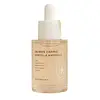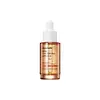What's inside
What's inside
 Key Ingredients
Key Ingredients

 Benefits
Benefits

 Concerns
Concerns

No concerns
 Ingredients Side-by-side
Ingredients Side-by-side

Centella Asiatica Leaf Water
Skin ConditioningButylene Glycol
HumectantWater
Skin ConditioningPropanediol
Solvent1,2-Hexanediol
Skin ConditioningGlycerin
HumectantSodium Dna
Skin ConditioningSalmon Egg Extract
Madecassoside
AntioxidantPortulaca Oleracea Water
Skin ConditioningPersea Gratissima Fruit Extract
EmollientMaltodextrin
AbsorbentHyaluronic Acid
HumectantHydrolyzed Hyaluronic Acid
HumectantTheobroma Cacao Extract
Skin ConditioningChenopodium Quinoa Seed Extract
Skin ConditioningHydrolyzed Wheat Protein
Skin ConditioningBetaine
HumectantDextrin
AbsorbentSodium Hyaluronate
HumectantCarbomer
Emulsion StabilisingEthylhexylglycerin
Skin ConditioningAmmonium Acryloyldimethyltaurate/Vp Copolymer
Tromethamine
BufferingDisodium EDTA
Centella Asiatica Leaf Water, Butylene Glycol, Water, Propanediol, 1,2-Hexanediol, Glycerin, Sodium Dna, Salmon Egg Extract, Madecassoside, Portulaca Oleracea Water, Persea Gratissima Fruit Extract, Maltodextrin, Hyaluronic Acid, Hydrolyzed Hyaluronic Acid, Theobroma Cacao Extract, Chenopodium Quinoa Seed Extract, Hydrolyzed Wheat Protein, Betaine, Dextrin, Sodium Hyaluronate, Carbomer, Ethylhexylglycerin, Ammonium Acryloyldimethyltaurate/Vp Copolymer, Tromethamine, Disodium EDTA
Water
Skin ConditioningButylene Glycol
HumectantNiacinamide
SmoothingPolyglycerin-3
HumectantMethylpropanediol
Solvent1,2-Hexanediol
Skin ConditioningGlycereth-26
HumectantGlycerin
HumectantMannitol
HumectantSodium Dna
Skin ConditioningPolyglyceryl-10 Laurate
Skin ConditioningMicrocrystalline Cellulose
AbsorbentAmmonium Acryloyldimethyltaurate/Vp Copolymer
Polyacrylate Crosspolymer-6
Emulsion StabilisingAcrylates/C10-30 Alkyl Acrylate Crosspolymer
Emulsion StabilisingArginine
MaskingZea Mays Starch
AbsorbentMilt Extract
Skin ConditioningEthylhexylglycerin
Skin ConditioningMica
Cosmetic ColorantAllantoin
Skin ConditioningCaprylyl Glycol
EmollientAdenosine
Skin ConditioningParfum
MaskingBiosaccharide Gum-1
HumectantCI 77492
Cosmetic ColorantSodium Hyaluronate
HumectantTranexamic Acid
AstringentCalcium Pantothenate
Maltodextrin
AbsorbentSodium Starch Octenylsuccinate
AbsorbentSodium Ascorbyl Phosphate
AntioxidantTocopheryl Acetate
AntioxidantPyridoxine Hcl
Skin ConditioningHydrolyzed Hyaluronic Acid
HumectantHydrolyzed Sodium Dna
Skin ConditioningHyaluronic Acid
HumectantSodium Acetylated Hyaluronate
HumectantTripeptide-1
Skin ConditioningAcetyl Hexapeptide-8
HumectantWater, Butylene Glycol, Niacinamide, Polyglycerin-3, Methylpropanediol, 1,2-Hexanediol, Glycereth-26, Glycerin, Mannitol, Sodium Dna, Polyglyceryl-10 Laurate, Microcrystalline Cellulose, Ammonium Acryloyldimethyltaurate/Vp Copolymer, Polyacrylate Crosspolymer-6, Acrylates/C10-30 Alkyl Acrylate Crosspolymer, Arginine, Zea Mays Starch, Milt Extract, Ethylhexylglycerin, Mica, Allantoin, Caprylyl Glycol, Adenosine, Parfum, Biosaccharide Gum-1, CI 77492, Sodium Hyaluronate, Tranexamic Acid, Calcium Pantothenate, Maltodextrin, Sodium Starch Octenylsuccinate, Sodium Ascorbyl Phosphate, Tocopheryl Acetate, Pyridoxine Hcl, Hydrolyzed Hyaluronic Acid, Hydrolyzed Sodium Dna, Hyaluronic Acid, Sodium Acetylated Hyaluronate, Tripeptide-1, Acetyl Hexapeptide-8
 Reviews
Reviews

Ingredients Explained
These ingredients are found in both products.
Ingredients higher up in an ingredient list are typically present in a larger amount.
1,2-Hexanediol is a synthetic liquid and another multi-functional powerhouse.
It is a:
- Humectant, drawing moisture into the skin
- Emollient, helping to soften skin
- Solvent, dispersing and stabilizing formulas
- Preservative booster, enhancing the antimicrobial activity of other preservatives
Ammonium Acryloyldimethyltaurate/Vp Copolymer (let's call it AAVC for short) is a synthetically created polymer. It's used as a film-forming agent and used to thicken the consistency of products.
AAVC is able to increase the consistency and viscosity of products due to its large molecule size. It also prevents ingredients from separating.
Butylene Glycol (or BG) is used within cosmetic products for a few different reasons:
Overall, Butylene Glycol is a safe and well-rounded ingredient that works well with other ingredients.
Though this ingredient works well with most skin types, some people with sensitive skin may experience a reaction such as allergic rashes, closed comedones, or itchiness.
Learn more about Butylene GlycolEthylhexylglycerin (we can't pronounce this either) is commonly used as a preservative and skin softener. It is derived from glyceryl.
You might see Ethylhexylglycerin often paired with other preservatives such as phenoxyethanol. Ethylhexylglycerin has been found to increase the effectiveness of these other preservatives.
Glycerin is already naturally found in your skin. It helps moisturize and protect your skin.
A study from 2016 found glycerin to be more effective as a humectant than AHAs and hyaluronic acid.
As a humectant, it helps the skin stay hydrated by pulling moisture to your skin. The low molecular weight of glycerin allows it to pull moisture into the deeper layers of your skin.
Hydrated skin improves your skin barrier; Your skin barrier helps protect against irritants and bacteria.
Glycerin has also been found to have antimicrobial and antiviral properties. Due to these properties, glycerin is often used in wound and burn treatments.
In cosmetics, glycerin is usually derived from plants such as soybean or palm. However, it can also be sourced from animals, such as tallow or animal fat.
This ingredient is organic, colorless, odorless, and non-toxic.
Glycerin is the name for this ingredient in American English. British English uses Glycerol/Glycerine.
Learn more about GlycerinHyaluronic acid is naturally found in healthy skin. It is a humectant, meaning it draws moisture to your skin.
This ingredient helps hydrate, soothe, and protect the skin.
What makes hyaluronic acid so hydrating? It has the capacity to bind or hold large amounts of water.
Fun fact: It is already naturally found in our bodies, such as the fluids of our eyes and our joints.
Studies find this ingredient to have anti-inflammatory and anti-microbial properties. This can help speed up wound-healing.
Hyaluronic acid can be irritating if the molecule has a low-molecular weight, or if the molecules are small.
One study found low-molecular weight hyaluronic acid to be pro-inflammatory, meaning some people may experience irritation. This is because our bodies use hyaluronic acid in the wound-healing process to signal to our bodies, via irritation, that something needs healing.
The same study found high-molecular weight hyaluronic acid to be anti-inflammatory.
These are some other common types of Hyaluronic Acid:
Learn more about Hyaluronic AcidHydrolyzed Hyaluronic Acid is a form of hyaluronic acid. It is created by the hydrolysis of hyaluronic acid with a high molecular weight. Once created, Hydrolyzed Hyaluronic Acid has a low molecular weight.
Low molecular weight HA has been shown to hydrate and increase elasticity of the skin. Increasing elasticity is also associated with reduction of wrinkle depth.
One study found topical low molecular weight hyaluronic acid may be considered for the treatment of rosacea in the adult population. However, we always recommend speaking with a professional about your skin concerns.
Hyaluronic acids are a humectant. This means they draw moisture from the air. Hyaluronic acids help moisturize, soothe, and protect the skin.
Read more about other common forms of hyaluronic acid:
Learn more about Hydrolyzed Hyaluronic AcidMaltodextrin is a polysaccharide. It is derived from starch such as rice, corn, wheat, or potato starch.
In food, Maltodextrin is used to improve the texture and thicken a product. Due to its structure, it can help create a gel texture. As an emulsion stabilizer, it helps keep the ingredients in a product together.
As a polysaccharide, Maltodextrin has moisturizing properties. Polysaccharides are a type of carbohydrate. The top layer of skin uses polysaccharides to retain water, keeping the skin hydrated.
Maltodextrin is water soluble and has a sweet taste.
Learn more about MaltodextrinSodium DNA is an emerging anti-aging ingredient.
It is created by taking deoxyribonucleic acid (DNA) and purifying it with sodium hydroxide.
The DNA is extracted from several different animal sources, including: calf thymus, the gonadic tissue of a male sturgeon, or herring / salmon sperm.
You have probably seen this ingredient in anti-aging skincare. But what is it?
DNA is composed of nucleotides, or chemical building blocks. Nucleotides include adenine (A), thymine (T), guanine (G), and cytosine (C). Talk about a flashback to biology! Nucleosides are formed from these nucleotides.
The science behind Sodium DNA is based on an ingredient called Polydeoxyribonucleotide or PDRN.
PDRN are DNA fragments mainly extracted from the sperm cells of trout or salmon. Meaning, PDRN can be derived from Sodium DNA.
PDRN consists of chains of nucleotides and nucleosides mentioned above. They can range anywhere from 80 - 2000 pairs.
Studies show PDRN has the following properties:
Most of the research on PDRN has been done using injectable forms. That’s important, because PDRN is a large molecule and doesn’t absorb well through the skin. So if you’re applying it topically, the effects are likely to be much milder.
Still, topical Sodium DNA is emerging as a trendy anti-aging ingredient. It’s generally well-tolerated and offers good biocompatibility with human skin, making it a low-risk addition to most routines.
Further studies are needed to truly confirm this ingredients anti-aging ability (Remember, retinol has decades of research!).
When using this ingredient, is is best to ask a brand about the source of their Sodium DNA. You'll want to find products where the Sodium DNA is sourced from fish. Some Sodium DNA is derived from calf / cow thymus.
Needless to say, this ingredient is not vegan.
Learn more about Sodium DnaSodium Hyaluronate is hyaluronic acid's salt form. It is commonly derived from the sodium salt of hyaluronic acid.
Like hyaluronic acid, it is great at holding water and acts as a humectant. This makes it a great skin hydrating ingredient.
Sodium Hyaluronate is naturally occurring in our bodies and is mostly found in eye fluid and joints.
These are some other common types of Hyaluronic Acid:
Learn more about Sodium HyaluronateWater. It's the most common cosmetic ingredient of all. You'll usually see it at the top of ingredient lists, meaning that it makes up the largest part of the product.
So why is it so popular? Water most often acts as a solvent - this means that it helps dissolve other ingredients into the formulation.
You'll also recognize water as that liquid we all need to stay alive. If you see this, drink a glass of water. Stay hydrated!
Learn more about Water